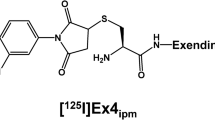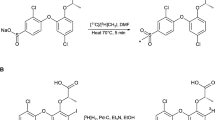Abstract.
The non-invasive detection of insulinomas remains a diagnostic problem that is not solved by means of somatostatin receptor scintigraphy. We investigated the biokinetics and specificity of uptake and degradation of the incretin hormone glucagon-like peptide-1 (GLP-1) in a rat insulinoma cell line (RINm5F) in order to ascertain whether radiolabelled GLP-1 may be suitable for specific visualisation of insulinomas in vivo. GLP-1 (7–36)amide was radioiodinated according to the iodogen method. The specificity of the uptake of [125I]GLP-1(7–36)amide by RINm5F cells was investigated. Degradation products of GLP-1 (7–36)amide in the cell medium were purified by HPLC. Their masses and amino acid sequences were determined by 252Cf-plasma desorption mass spectrometry. Lysosomal degradation was inhibited and after differential centrifugation the amount of radiotracer incorporated into lysosomes was determined. Biodistribution studies were performed in a rat insulinoma model (NEDH rats and RINm5F cells) with [123I]GLP-1(7–36)amide and its more stable agonist [123I]exendin 3. The uptake of radiotracer into insulinoma cells reached a maximum within 5 min. It was inhibited by an excess of unlabelled peptide. [125I]GLP-1(7–36)amide accumulated in the cells if lysosomal degradation was inhibited. Degradation products of the peptide were found in the cell medium. We determined their mass and derived their amino acid sequence. Radiolabelling of exendin 3 was more difficult than that of GLP-1 because of the lack of tyrosine in its primary structure. Biodistribution studies showed rapid blood clearance and uptake of the radiotracer into the tumour and the pancreas. It was also possible to detect insulinomas in an animal model by external scintigraphy using radioiodinated GLP-1 (7–36)amide and exendin 3. GLP-1 (7–36)amide is specifically internalised into insulinoma cells by a receptor-mediated mechanism. Our results demonstrate that GLP-1 receptor-directed scintigraphy may be a new method for the detection of insulinomas in vivo. Due to the short half-life of GLP-1, its more stable analogue exendin 3 may better suit this purpose in vivo.
Similar content being viewed by others
Author information
Authors and Affiliations
Additional information
Received 27 September and in revised form 1 January 2002
Electronic Publication
Rights and permissions
About this article
Cite this article
Gotthardt, M., Fischer, M., Naeher, I. et al. Use of the incretin hormone glucagon-like peptide-1 (GLP-1) for the detection of insulinomas: initial experimental results. Eur J Nucl Med 29, 597–606 (2002). https://doi.org/10.1007/s00259-002-0761-1
Published:
Issue Date:
DOI: https://doi.org/10.1007/s00259-002-0761-1




